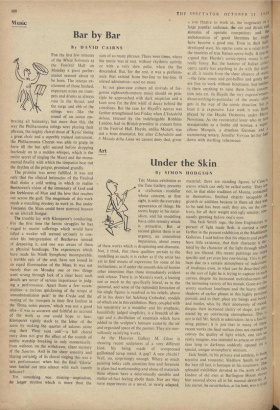Art
Under the Skin
By SIMON HODGSON
.THE Manzu exhibition at the Tate Gallery presents a craftsman - modeller whose concern, at first sight, is with the everyday appearance of things. He seems happy in his natur- alism, and his modelling has a calm serenity which is attractive. But at second glance there is an urgency, an unresolved impatience, about many of these works which is disquieting and dramatic. Not, I think, that these qualities pertain to the modelling as such; it is rather as if the artist has yet to find means of expression for some of his inclinations; as if under the smooth skin of bronze other intentions than those immediately evident seek release. There is. in Manzu's work, a leaning not so much to the specifically literal, as to the pictorial, and some of the (splendid) limitation of his single figures is resolved in his reliefs, above all in his doors for Salzburg Cathedral, models of which are in this exhibition. Here, coupled with his sensitivity as a modeller and his emphatic, beautifully judged simplicity, is a breadth of de- sign and a distillation of essentials which have added to the sculptor's humane austerity the air and organised space of the painter. They are mar- vellously satisfying works. At the Hanover Gallery M. Cdsar is showing recent sculptures of a very different kind, his being made of compressed guillotined scrap metal. A gag? A new chi-chi? Well, no, surprisingly enough. Where so much painting today calls attention first and foremost to plain bad workmanship and abuse of materials these objects have a determinedly sensible and matter-of-fact feeling about them. Nor are they mere experiments in a novel, or newly adapted, material; there are standing figures in' Coors (euvre which can only be called noble. They are not, in that older tradition of Manzu, contained in themselves, finished objects incapable 0f growth or addition because in them all that was to be said has been said; they are, on the on' trary, for all their weight and ugly solidity. c°11• stantly growing before one's eyes. The Jack Smith saga, the lone Englishmanin pursuit of light made flesh, is carried a stage farther in the present exhibition at the Matthiesen Galleries. I said before that his objects and peoPle have little existence, that their character is dic' tated by the character of the light through which they are filtered. His recent paintings are more specific and yet even less convincing. This is per haps due to a certain atmosphere of indecision. of weakness even, in what can be described as the sort of light he is trying to capture in each canvas, despite his increased meticulousness and the increasing variety of his moods. Gone are II" wintry seashore loneliness and the heavy umber shadows of earlier phases in this highly persona' pursuit; and in their place are beings and books and bottles who, by their anonymity despite their increased clarity of shape, are ant' by no convincing atmospherics. This. is not to fail Mr. Smith in admiration; he is a fascia' painter; it is just that in many of these recent works the final surface does not manage to convey the quality of light which, one can s° easily imagine, was intended to amaze or mystify eyes long in darkness suddenly opened on a special, unique atmospheric moment. Jack Smith, in his privacy and subtlety. is both tthew Smith, scientist and romantic; Ma of mood.. h, to save the best till last, is baroque in his assurance. The splendid exhibition devoted to the work of this ,0 kindest of old men at Burlington House shoes him assured above all in his manual dexterity.. A. late starter, he nevertheless, at his best, was a ilea' to Delacroix in the exactly judged touch, the free sweep of the brush answering exactly the dramatic necessities of a picture. His ebullience, both as a designer and as a colourist, at some stages of his career, can blind one to the real mastery and con- trol of even his wildest splendours, and can lead one to forget the other moods and approaches through which he passed. If his eloquence some- times flowers in rather empty and meaningless areas of paint, if his baroque brush-strokes some- times exist without necessity or proper direction in over-eager backgrounds, both can, and in the pictures now being shown often do, achieve har- monies of form and colour that no English artist of this century can equal. We live in an age of astringency and fashion; Matthew Smith, for all his ties with France and Fauve painting, belongs to a long line of artists to whom the fruits of the earth, publicly enjoyed in a variety of moods, are inspiration for a lifetime. He was a great giver.



















































 Previous page
Previous page